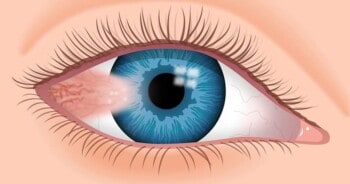So you’re going to ride the waves, be it surfing or skimboarding, have you ever thought of protecting your eyes?
You might have packed your wetsuits, sunscreen and surfboard, what about something to protect your precious eyes?
Everyone wants to enjoy surfing as much as possible but great vision is key. As a surfer, you are at high risk of catching eye conditions and infections.
One common eye condition among surfers is the scary surfer’s eye. Fortunately, surfer’s eye can be prevented effortlessly without interfering with your surfing experience.
In this article, you will learn how to prevent surfer’s eye with ease. In the end, you should be able to identify and treat it.
First, you should know what surfer’s eye is. Let’s get started!
Table of Contents
What is Surfer’s Eye?
Surfer’s eye is an elevated flesh-like or wing-like bump or growth that grows on the conjunctiva across the eyeball. Also known as pterygium, it looks scary but it is non-cancerous, often pink in color, and mostly less threatening.
Most times, it starts small from the corner of the eyeball near the nose and continues until it covers the pupil. However, it may also grow out from the other edge.
In fact, the growth can appear on either eye or both. If unattended to, it can cause discomfort, cover the eyeball, affect vision, and even disfigure the eye permanently.
What Are the Signs and Symptoms of Surfer’s Eye?

Early detection and paying attention to your body are important in treating the surfer’s eye. Like many other medical conditions, the surfer’s eye does come with signs and symptoms.
Commons symptoms include burning and itching feeling in the eye, eye redness, dry eyes, headache, and inflammation of the eyes. You may also feel the presence of a strange object in your eyes.
In more advanced cases, your vision may be blurred or impaired. Sometimes, the presence of yellow patches on the white part of your eye (pinguecula) can be a precursor. When you start seeing all these signs and symptoms, do not panic but see a doctor.
What Causes Surfer’s Eye?
You must be having a lot of questions on your mind now! Like how common is surfer’s eye? Or even, is surfer’s eye contagious?
First, you should understand that surfer’s eye is non-cancerous, non-contagious and there are effective treatment procedures. I will be talking about them in the next section.
So what causes surfer’s eye? Surfer’s eye is mainly caused by continuous exposure to harmful UV rays of the sun. As the sun’s UV continues to reach your eyes, the growth can develop rapidly.
Some other irritants such as wind, dust, sand, seawater, air pollution, and chemicals can also cause surfer’s eye. In rare cases, it can be hereditary. So then, why must it be surfers?
That it is called surfer’s eye doesn’t mean it is restricted to surfers alone. Anybody can have pterygium. However, it is very common among surfers even if it’s skimboarding, paddleboarding, windsurfing, or regular surfing.
As long as surfing is an outdoor sport, surfers are at greater risk. This is basically because they are exposed to large amounts of these irritants. Even the reflection from the water, sails, and sand can also contribute to the growth of pterygium.
The occurrence of pterygium may, however, vary depending on location, age, and gender. Male are more likely to suffer pterygium than females whilst older people have a higher tendency.
5 Simple Ways to Prevent Surfer’s Eye

1. Wear Surfing Goggles
As a surfer, you have a higher risk of surfer’s eye due to your exposure to large amounts of UV rays. To protect your eyes, you should always remember to put on your surfing goggles. Even if you will be closer to the beach using skimboards, surfing goggles are necessary.
Surfing goggles can help cut down on the quantity of UV rays entering your eyes. They can also shield your eyes from sand particles and other foreign objects.
Since your safety matters, don’t just buy any pair of surfing goggles but look for the best for you. Surfing goggles also come with straps that help to secure them on your face. Even if they fall off, they will float so you can find them easily.
Some goggles are even water-tight enough to keep water away from your eyes. When going to the beach with your surfboard and wetsuit, always put one in your surfboard travel bag too.
2. Wear Sunglasses and Hats
There are many shades that can offer 99 percent protection from UV rays. Even when you are off the beach, you should also keep your eyes safe from those stray UV rays.
When buying your sunglasses, you should look out for those with anti-glare properties. Hats and caps can also shield you from UV rays too.
3. Wash Your Face After Surfing
After spending a wonderful time on the beach, I recommend that you wash your face. It is very possible that your face accumulates potential irritants that can trigger the development of surfer’s eye.
Ideally, you should use lukewarm water. Of course, using hot water can cause burns and cold water will cause dryness and even block facial pores.
4. Maintain a Healthy and Humid Indoor Airflow
Sometimes, your environment can influence the development of surfer’s eye. Staying in a dry, dusty environment can be unhelpful and can potentially increase your risk of having it. If the air inside your home or office is dry and dusty too, it’s more risk.
Try as much as possible to keep your home humid and the air indoors moist. You can purchase humidifiers to do that for you. Alternatively, you can place some amount of water in some containers in your room and leave them uncovered.
5. Moisturize Your Eyes Regularly
The more you engage the surfing, you need to moisturize your eyes regularly. Eye moisturizers or eye drops can help you maintain moisture levels in your eye whilst keeping the pH balance.
3 Steps to Treating Surfer’s Eye
Even though surfer’s eye looks scary, it is benign and absolutely treatable. Early detection, as well as, seeing a doctor early plays an important role in treatment.
The rate of healing varies but, generally, smaller pterygiums heal faster than larger ones. Below are some steps on how to treat surfer’s eye:
1. See a Doctor
Now that you have known the signs and symptoms of the surfer’s eye, you should consider seeing a doctor. In this case, you should see an ophthalmologist i.e. a doctor responsible for treating eye diseases and conditions.
This is the most important step to start with. Such doctors can determine if it’s truly surfer’s eye or another eye condition. They will be able to gauge the level of severity of your eye condition and determine the next level of action. However, keep calm!
2. Use of Drops
In mild conditions, your doctor can prescribe artificial tears or non-steroid eye drops. Basically, they act as topical lubrication to prevent dryness, soreness, and reduce other symptoms.
If your condition seems severe, steroid eye drops will help to reduce continuous irritation. However, you should only use them based on your doctor’s prescription.
If used for too long, it can be dangerous. It can increase your risk of having other eye-related diseases such as glaucoma.
3. Surgery
Depending on your doctor and the severity of the pterygium, a surgical procedure might be what is needed. If left unattended, a pterygium can cause scarring and ultimately lead to poor vision.
During the surgery, the doctor will take out the unwanted growth and graft another portion of the conjunctiva. In most cases, the surgery requires anesthesia and it doesn’t take up to an hour.
It is important to know that removing pterygium can cause astigmatism, scars, and blurry vision. After the surgery, you may have to wear an eye patch for up to a week for proper and faster healing.
Notwithstanding, you may also experience soreness and, sometimes, redness. Your doctor may also encourage you to use anti-metabolites as they can help reduce or inhibit the regrowth of pterygium.
Unfortunately, even after removing pterygium, there might be cases of reoccurrence. Therefore, you should avoid dusty and dry environments.
More importantly, you should also commence wearing protective gadgets. The prevention tips I discussed above should be practiced properly.
FAQs
Here are some frequently asked questions on surfer’s eye. You might find them useful.
Is Surfer’s Eye Contagious?
No! Surfer’s eye is not contagious. It is caused by excessive exposure to ultraviolet rays and irritants. You simply can’t catch it or unintentionally infect someone else.
Is Surfer’s Eye Permanent?
No! Surfer’s eye may heal with little or no treatment. However, in some cases, if care is not taken and treatments commenced, surfer’s eye may remain for a long time. It can even disfigure the eye permanently, drastically affecting vision.
Therefore, seeing a doctor is important. Treatment includes drops for milder cases abs surgery for severe ones.
Can surfer’s eye affect vision?
Surfer’s eye is non-cancerous and non-infectious. It does not infect other body parts. Nevertheless, it can potentially cause blurred vision.
Conclusion
Protecting and taking care of your eyes is very important as a surfer. Surfers are most affected due to surfing conditions. These conditions don’t help since you are exposed to wind and sun at all times.
As you can see, preventing surfer’s eye is better than treatment. In fact, eye diseases and conditions, generally, can be challenging. Therefore, you should not take any risk as it can damage your vision.
Remember, good vision is needed to surf those waters. By now, you should know how to prevent surfer’s eye and also how to identify them.
Help other surfers identify and prevent surfer’s eye by sharing this article with your friends and family on Facebook, Twitter, and other media platforms.
Do you have questions, comments, or suggestions? Kindly use the comment box below.

